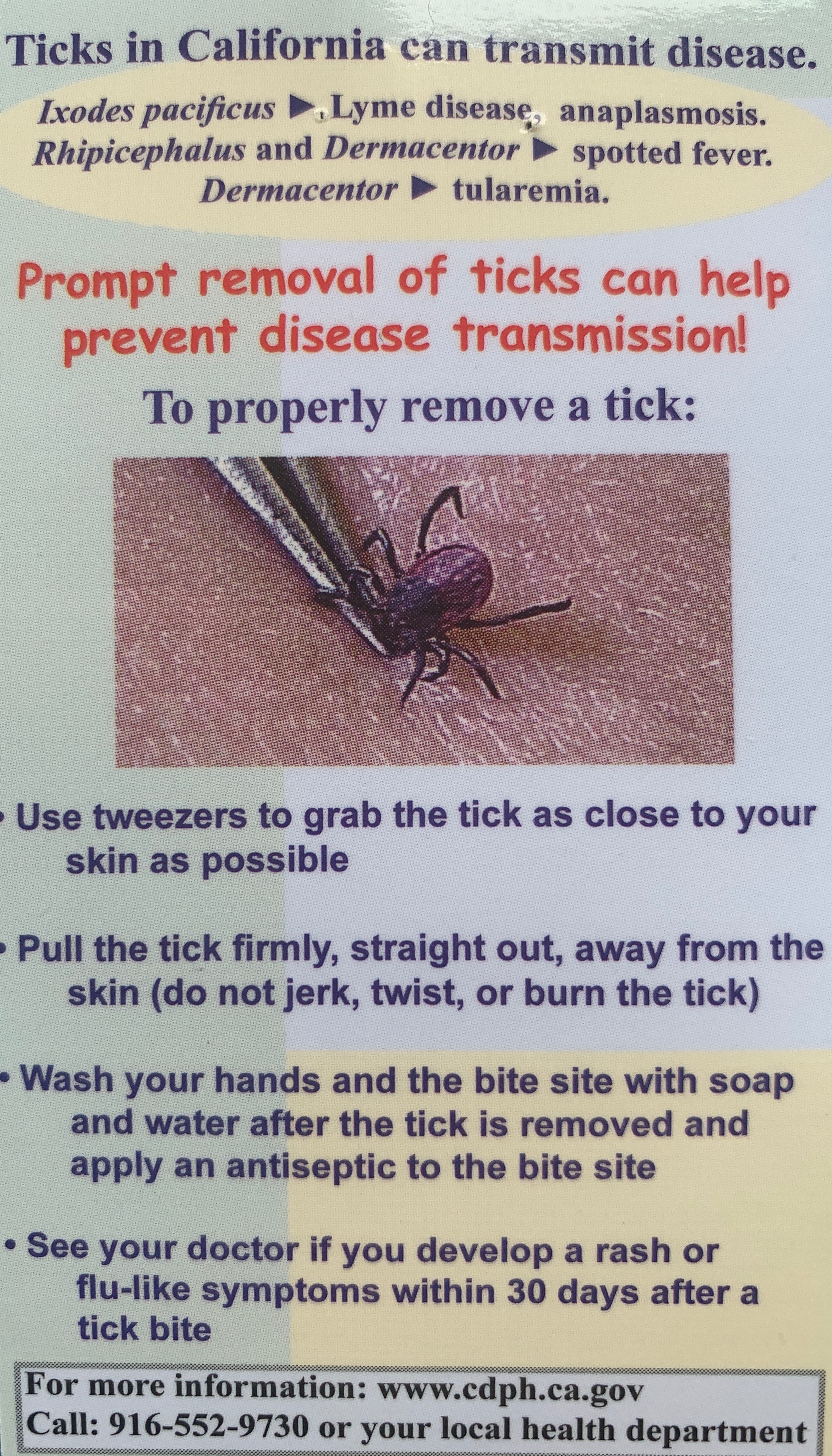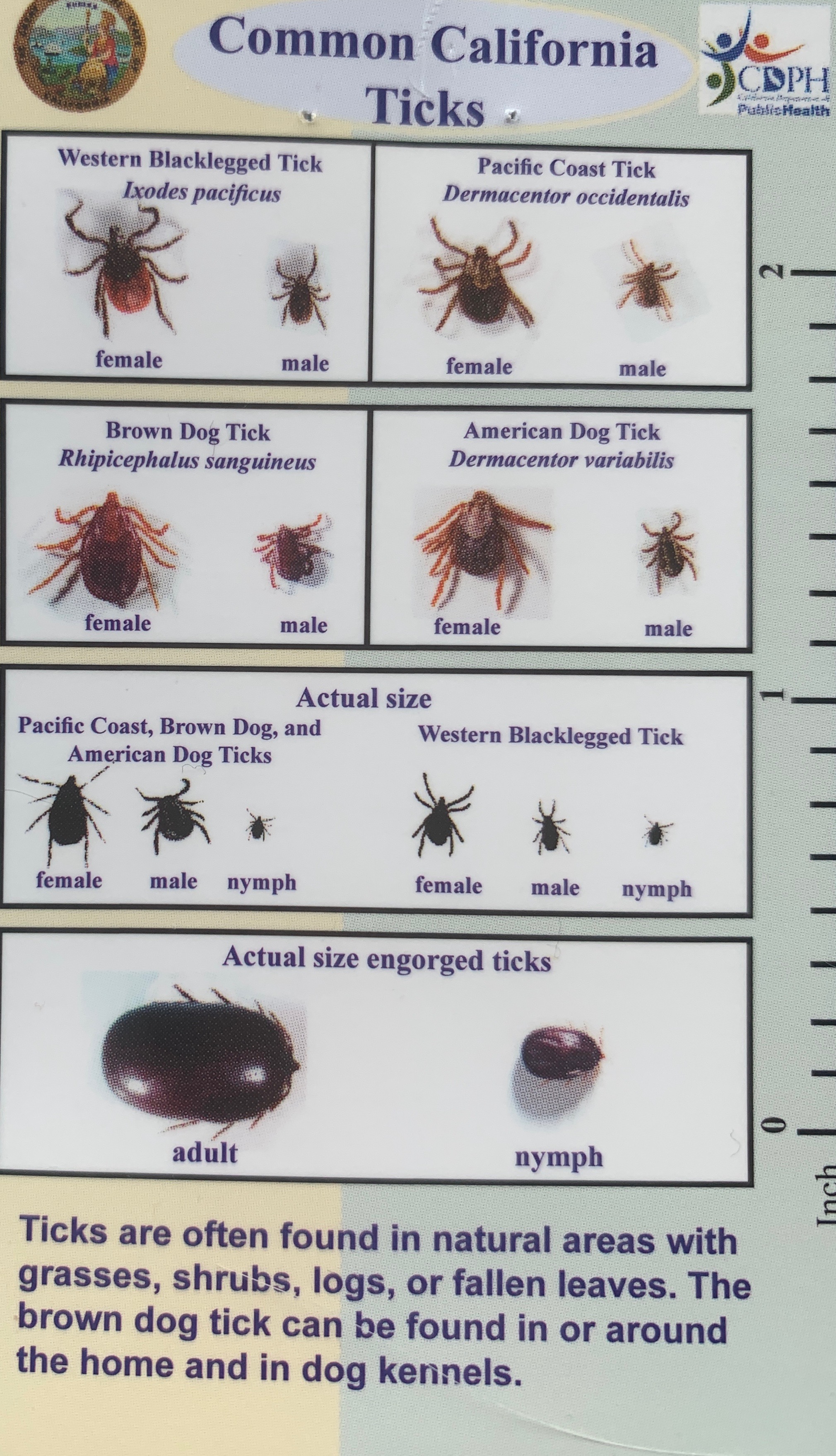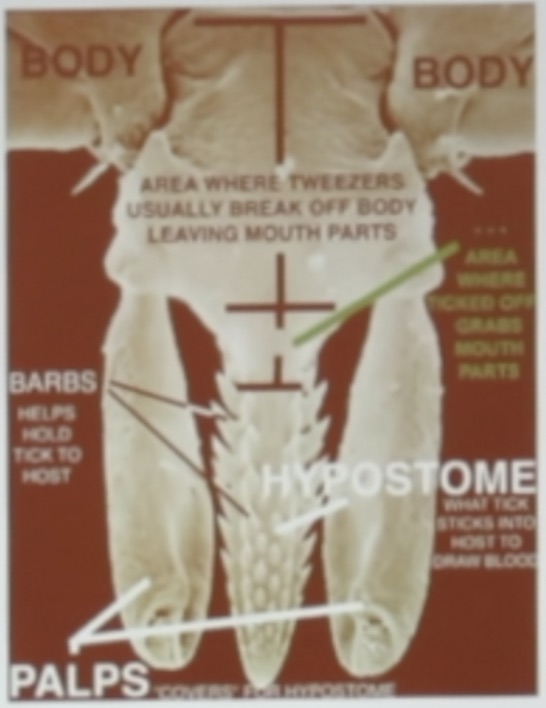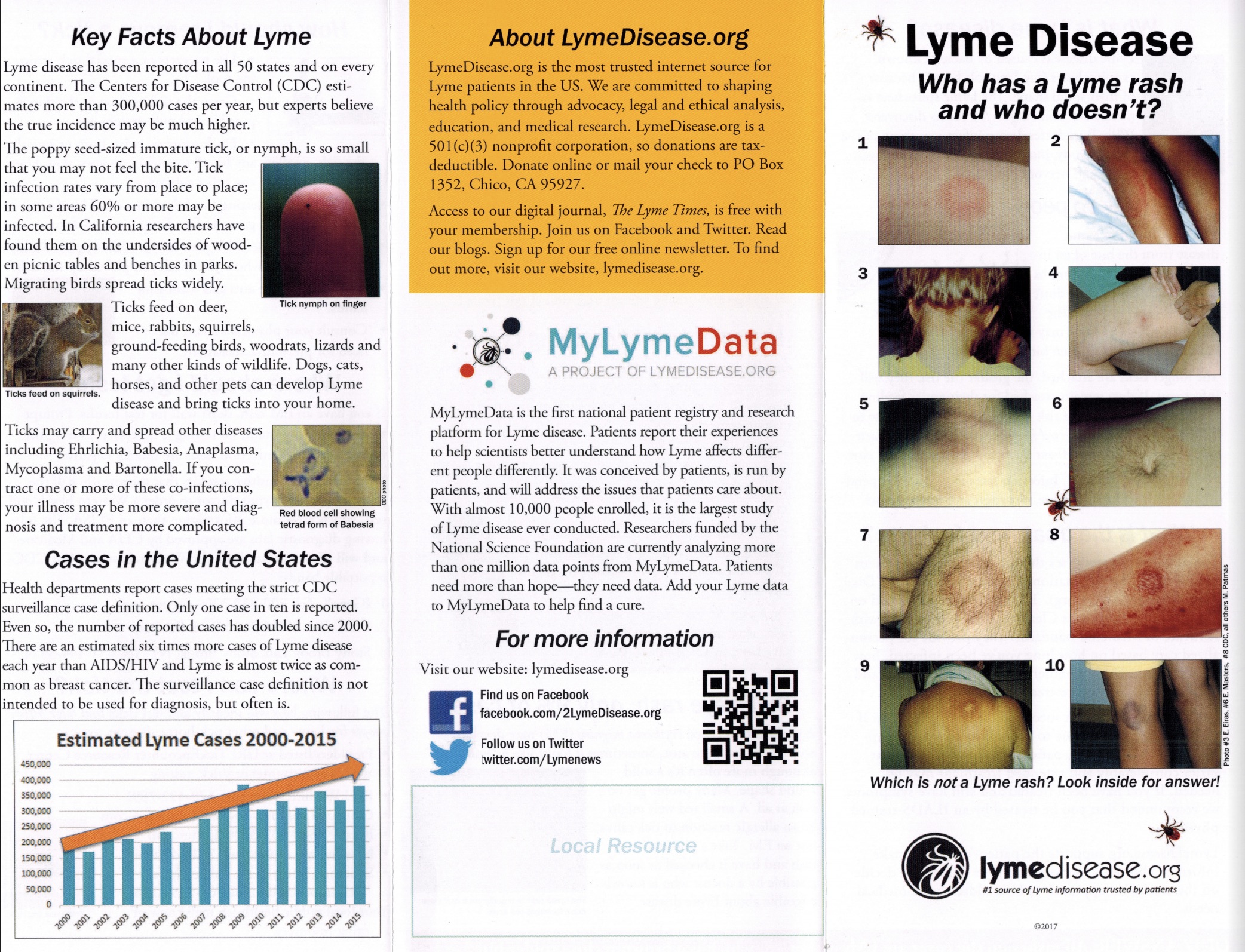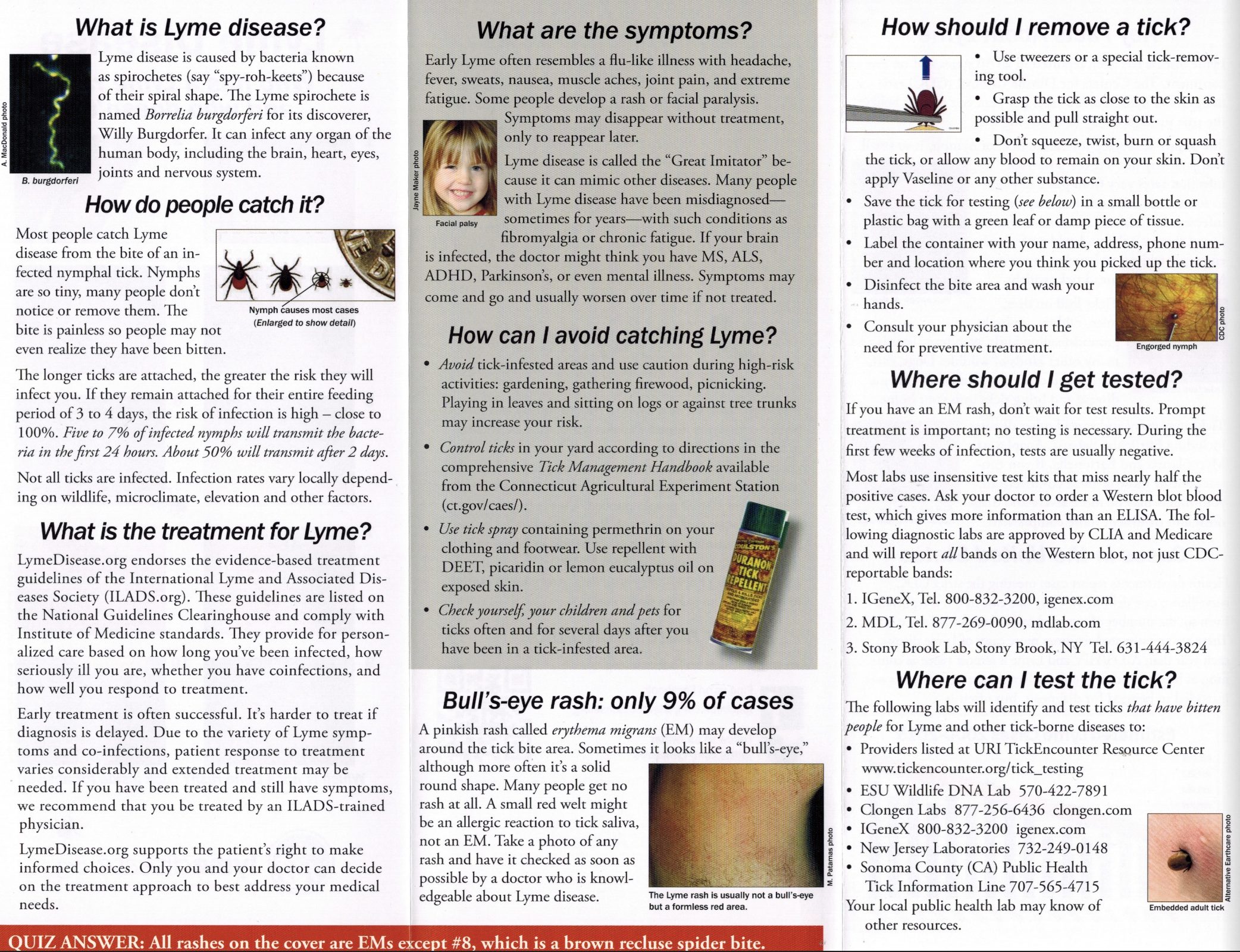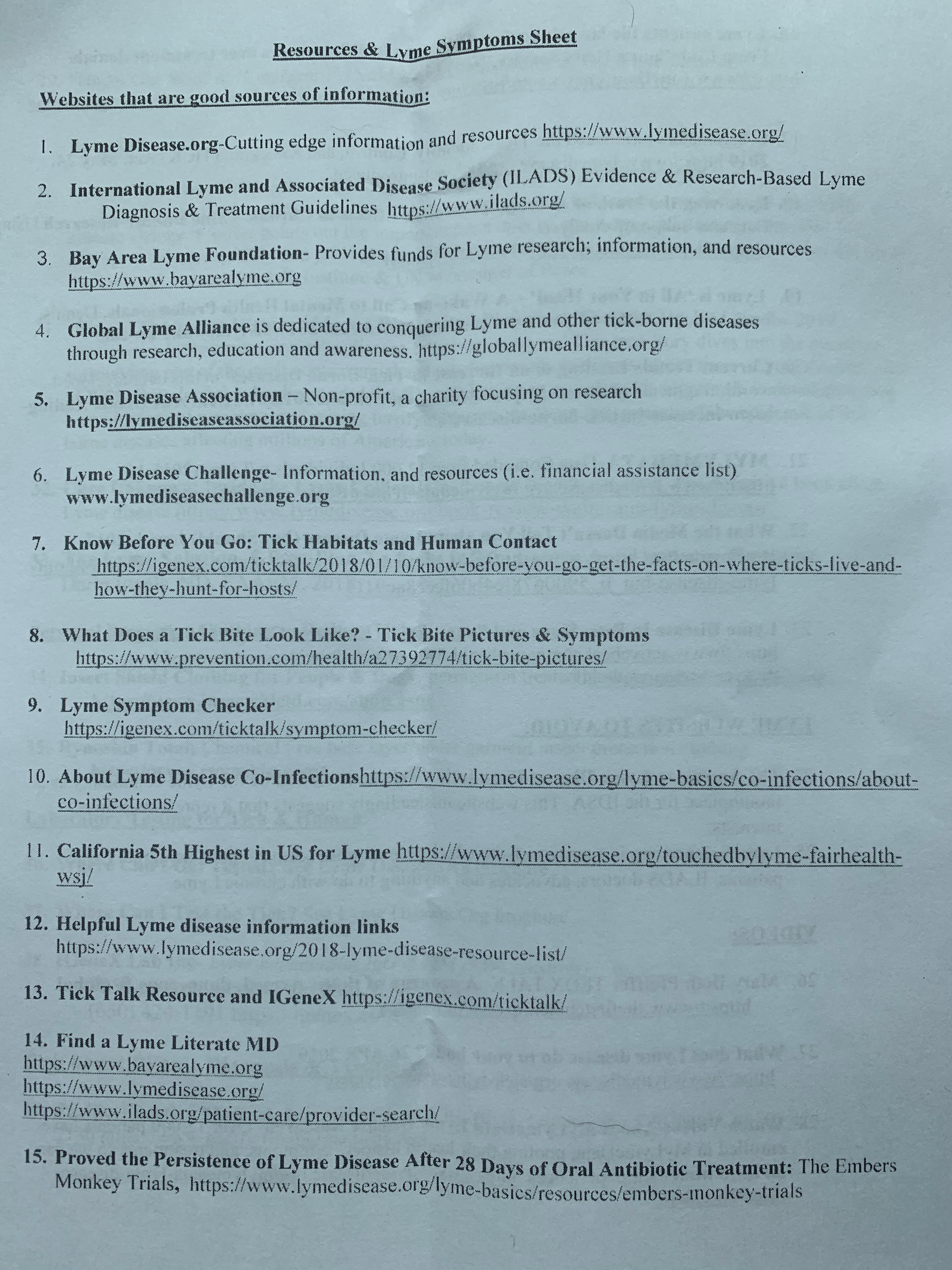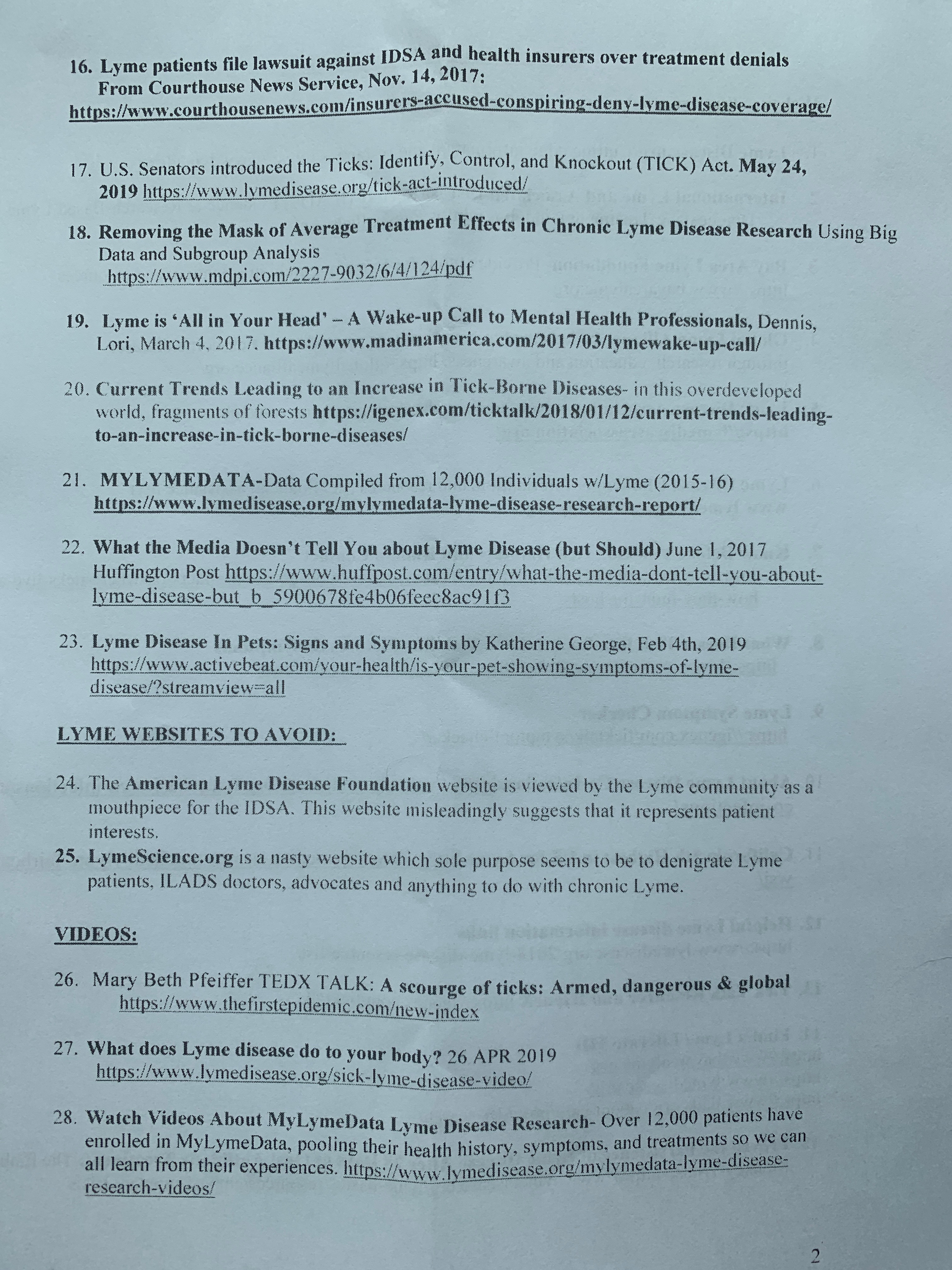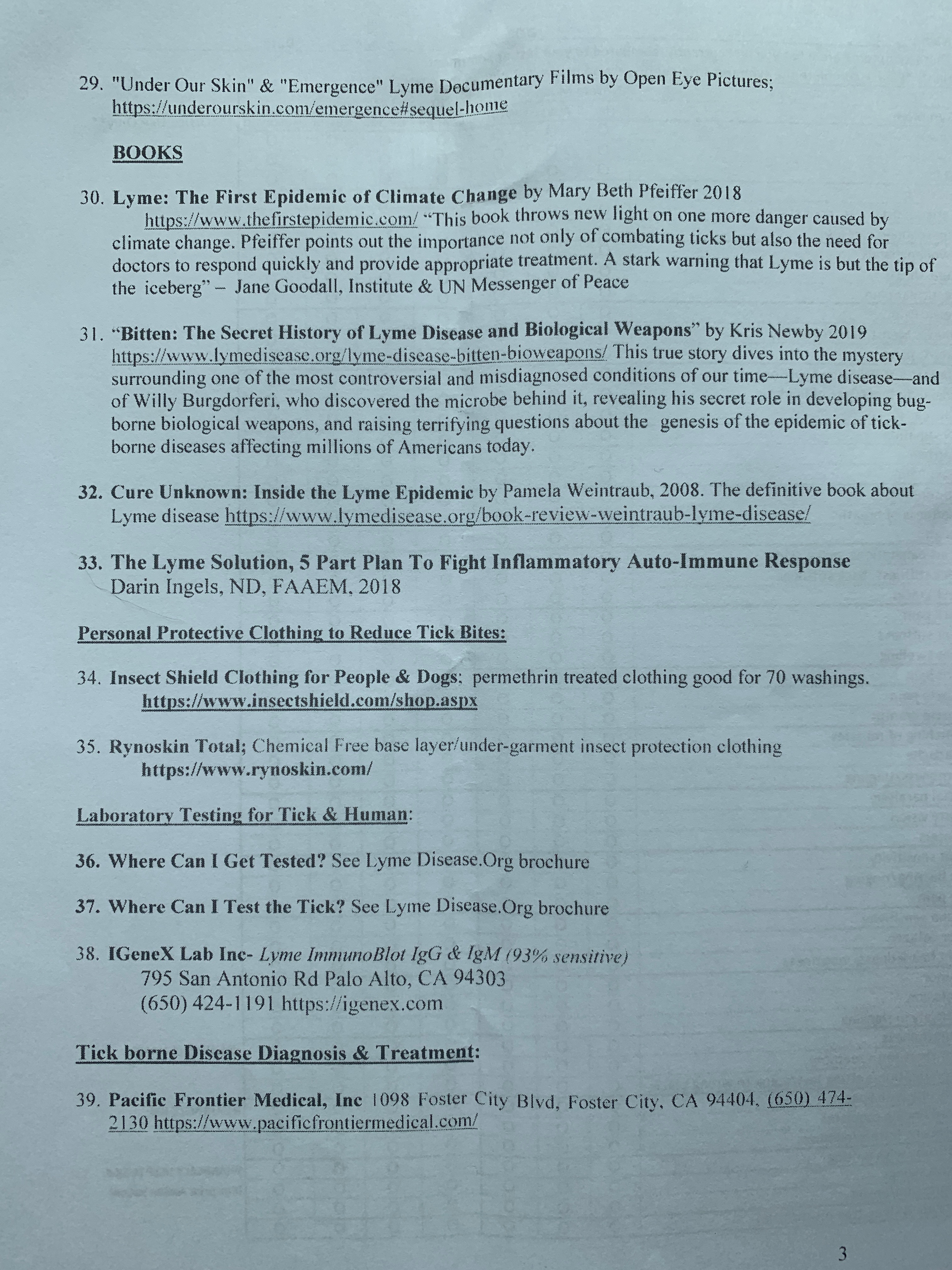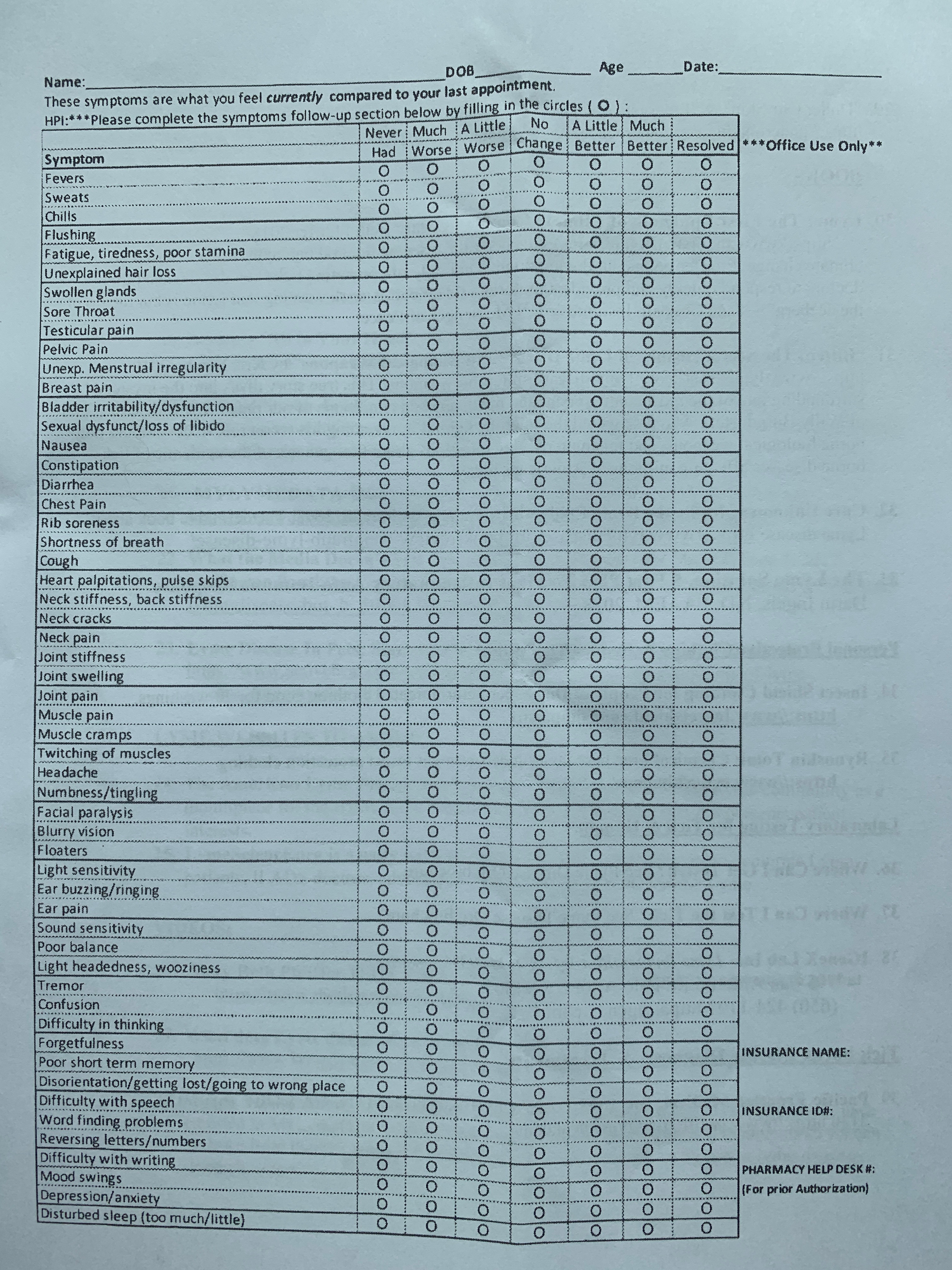|
Getting your Trinity Audio player ready...
|
LECTURE / VIDEO / LINKS.
Infected ticks and Lyme sufferers are found in 30 countries worldwide, all 50 states in the US, 42 of the 58 counties of California, and in every park on the San Francisco Peninsula.
In 2017, more Americans were infected with Lyme disease than women who contracted breast cancer and 11 times as many as contracted HIV. Steve Diers, retired ranger and naturalist of 39 years, contracted Lyme in 1995 while working for EBMUD.
Steve strongly believes that education is the most important way to reduce your risk and increase your awareness of tick–borne diseases.
Save the Tick, Test the Tick ? ? <<<<< CLICK FOR MORE
“Testing of ticks is NOT recommended by the Center for Disease Control (CDC) and California Department of Public Health (CDPH), because a tick tested positive for Lyme disease does not necessarily transmit the bacteria to human, and a tick tested negative does not guarantee the patient is free from infection (if unknowingly bitten by a different infected tick). All medical diagnosis should be based on the patients symptoms, and appropriate treatment should start early; do not wait for the test results of the tick.
Ticks brought to or mailed to your local vector control for identification should be put into a zip-lock plastic bag with water moistened cotton or tissue.
If you have been bitten by a tick and want it tested for tick-borne diseases, you can submit the tick to a number of laboratories within the Bay Area or other states for testing.
We do not endorse any of the following laboratories but are providing this information as a public service.
1. Testing procedures will vary if the tick is alive or dead. Ticks that are alive or have been recently killed may be tested by Indirect Fluorescent Antibody (IFA). Click here for laboratories that will test ticks by IFA tests
~ Alameda County Vector Control
ARTICLE / VIDEO / LINKS. Ticks are Here on the San Mateo County Coast. And so is lyme disease (see Robert Buelteman’s video below). San Mateo County reports a low lyme disease case count. But many on the coast have gone through horrifying experiences with undiagnosed lyme disease. I had a friend from Hawaii go to Seton Coastside with a tick hanging on. The doctor removed the tick and threw it out. The low count may be due to the fact that testing is not being done systematically by doctors in San Mateo County.
Ticks may carry Lyme disease. How it works biologically. Tick bites you and your blood enters its stomach. The ticks stomach contents carries the microorganism that causes Lyme Disease (Borrelia burgdorferi). Your blood and the tick stomach juices mix. The the tick takes in more and more of your blood, until they are engorged. But there is no backwash valve on the tick’s mouth and so their stomach’s contents enter your blood stream. This takes anywhere from 12-36 hours.
For only $25 your get your tick tested by the San Mateo County Health System.
“You are NOT Out of the Woods.
What if the ticks head breaks off in the skin and the tick bleeds to death? I am pretty sure the tick has to be alive or have its body fluids intact to test it. Remember the measly 28 days of oral antibiotics a mainstream MD gives a patient will work best if it is given right after the bite.
If not “the clock is ticking” and the longer one goes before starting this measly treatment the less chance the oral antibiotics will be able to kill the spirochete Lyme form before it lodges in tissue & organs as the cyst or biofilm Lyme forms which are resistant to most antibiotics.
Lyme symptoms can occur in as little as 3-31 days after the bite.
Only 25% of the individuals who contract Lyme remember being bitten.
What about the other 75%?
- If the tick is sent through the mail to a lab to be tested it takes 7-10days from when the lab receives it before you will receive results in the mail.
- Keep a chronology of the date you were bit, and any of the symptoms you develop after the bite.
- It is more important to get prompt prophylactic treatment than to get the tick tested because the Lyme bacteria may spread widely in the body, including to the brain, within hours/days. In 7% of cases the bacteria can be transmitted in 12 hours or less.
- If you have been infected; the more time that lapses between the bite and the start of treatment can mean the treatment can be less effective.”
~ Steve Dier
>>>>CLICK FOR MORE ON TICKS
PREVENTION ~ Reduce Your Chances of a Tick Bite
- Reduce your exposure by avoiding areas where and when ticks occur.
- Walk in the middle of trails and avoid brushing up against grasses on path edges where
adult ticks may be. - Questing adult ticks will be on the uphill side of north facing trail in moist ecotones. 80%
of them will be on uphill side and 20% will be on the downhill side of the trail. - Don’t sit on logs, against trees or on rocks with vegetation on them such as moss where
nymph ticks may be. - Avoid pitching a tent, crawling, sitting or lying in leaf litter where nymph ticks may be.
- Wear light-colored long pants and long sleeves so you can easily see any ticks.
- Tuck shirt into pants and tuck pants into socks.
Perform Tick Checks after Being in Tick Habitat Where Ticks Occur
- This is one of the most important prevention measures. Ticks, especially nymphal ticks, are
tiny. Find and remove them before they bite. Inspect your clothing and exposed skin for
ticks often when outdoors in likely tick habitats. Ticks may attach anywhere on the body,
but on fully clothed persons they often attach to the scalp, behind an ear, or to an arm or
leg. Pay particular attention to these areas when examining yourself or others. Furthermore,
examine your bedding for up to several days after exposure to tick-infested habitats for
presence of detached, fed ticks. Nymphs of the black-legged tick, once attached to human
skin, are easily overlooked because of their small size and sometimes hidden feeding sites
(such as the scalp). However, fully satiated nymphs have been observed to detach from
people during the night within as few as 3 days after exposure to ticks, and they are much
easier to detect in a bloated state while digesting their blood-meal among bedclothes,
including one’s pillow. - Ticks are tough little buggers! After the Chernobyl nuclear plant melt down in 1986,
researchers found specie of tick carrying disease thriving within the plant exclusion zone. If
you wash clothes with tick on them the ticks may still be alive when you take the clothes
out of the washer. Better yet; throw your clothes in the dryer. The ticks will become
desiccated and die! - Do a thorough tick check upon returning inside and for several days following
exposure. - Check bedding for several days following exposure for ticks that drop off.
Personal Protective Equipment
Insect Shield Clothing for People & Dogs
https://www.insectshield.com/shop.aspx permethrin treated clothing good for 70 washings. It is
pricy but far better than contracting Lyme.
Send in your own clothing to be treated with permethrin and they are good for 70 washings! This
is more economical so one could have more of their own clothing (pants, shirts, Tee shirts, socks,
etc) treated resulting less washing. https://www.insectshield.com/IS-Your-Own-Clothes-P338.aspx
Permethrin is a man-made version of a natural repellent found in chrysanthemum flowers native
to Africa. Insect Shield Repellent Apparel puts insect repellency near your skin, instead of on
it, and the protection is invisible.
Also, the repellency is long lasting, so no re-application is
needed. The proprietary Insect Shield process is designed to prevent loss of active
ingredient outside the system, and once applied,
Insect Shield repellency is so tightly bound to
fabric fibers that garments retain effective repellency through 70 launderings. Insect Shield®
Repellent Apparel has been registered to repel mosquitoes, ticks, ants, flies, chiggers, and midges
(no-see-ums).
Rynoskin Total CHEMICAL FREE base layer/under-garment insect protection clothing
It is specifically designed to be worn underneath the clothing. This unique concept provides the
wearer with comfort, breath-ability, and stealth movement. I think for complete protection one
would need the total hood and perhaps the gloves. These clothes come in 4 different colors. It is
pricey but far better than contracting Lyme. I recommend that a person should purchase a number
of each (shirt, pants, socks, total hood & gloves) so they wouldn't have to be washed so
often. Rynoskin Total does not support the claims that you are protected from Ants, Spiders, Bees,
and Wasps https://www.rynoskin.com/
SSgt Nathanial Reeves of SS Bravo Company 980th EN BN a soldier serving in Iraq, has
used RYNOSKIN in an extreme climate and it has allowed his skin to breath. His duties
exposed him to severe climates, hot to cold to wet and dry. RYNOSKIN has provided him with
protection from pesky insects. He recommended it to other soldiers as well as for
everyday activities.
Keep Ticks at Bay by Using Pesticides in a Responsible Manner
- Follow the manufactures directions.
- Repellents applied to the skin containing DEET or Lemon Eucalyptus oil applied every 7
hours have been rated “good” for mosquitoes & ticks. DEET has been associated with
human case histories of neurological damage and even death, and products greater than
40% are restricted in some states. It is recommended that 30% or less DEET is applied on
exposed skin of adults and 10% on children. The Centers for Disease Control recommends
that consumers avoid products that mix sunscreen with DEET insect repellent. Because
sunscreen needs to be applied heavily and often and by doing so with this type of product
you could expose yourself to higher concentrations of DEET unnecessarily. In the 1990's
my employer provided us with a bottle of 98% DEET insect repellent which always leaked.
I kept mine in a plastic sandwich bag and it melted the plastic. I decided later who would
want to spray themselves with 98% DEET if it melts plastic? (9,70,74) - The Centers for Disease Control lists Lemon Eucalyptus Essential Oil as an
organic product as an effective repellent for ticks that can carry Lyme disease.
Lemon Eucalyptus Essential Oil is not recommended for children under 3. A
commercial product called Repel Lemon Eucalyptus Repellent, from Spectrum
Brands is available. (74, 75) - Spraying pesticides containing DEET such as “Off” or “Cutters” on your skin is
not as effective as garments treated with Permethrin products. You would need tospray your whole body every 7 hours with pesticides containing DEET or Lemon
Eucalyptus oil to have the same effectiveness as insect repellant clothing. (19,70). - Pesticides that are made to be applied to the skin such as Repel Lemon Eucalyptus
Pump Insect Repellent, "Off” or “Cutters" that has 40% or less DEET (10% on
children). To apply to the face do not spray them onto the face. Instead put some
on your hand and then apply it to your face. - Spraying pesticides containing DEET on clothing is NOT effective against ticks. In a
field test conducted by the Minnesota Insect-Borne Disease Education Council in Jay Cook
State Park in Northern Minnesota, permethrin products were found to out-perform the
DEET-containing tick repellents. A walking shoe was sprayed with Duranon 0.5%
permethrin: three weeks later it was tested against its matching mate that was sprayed with
Deep Woods Off 35% DEET. The ticks that made contact with the Duranon 0.5%
permethrin shoe immediately rolled up and dropped off. The ticks on the soaking wet
DEET saturated shoe continued to crawl unimpaired. (70) - Recommendations: Insect repellant clothing is now available – clothing that
comes pretreated with repellant that stays in the garments for numerous washes.
Insect Shield(R) apparel and accessories are available now. This clothing for
people and their dogs are treated with 0.5% permethrin. The University Of North
Carolina Gillings School Of Public Health reported that the incidence of tick
attachments was reduced by 93 percent among workers wearing Insect Shield
Repellent Apparel. The report was published online March 11, 2011 in the journal
Vector-Borne and Zoonotic Diseases. Also there is Rynoskin Total Chemical
free base layer/under-garment insect protection clothing available. - Another option is to spray one pair of long pants, one long sleeve shirt and a ball
cap with a repellent containing Permethrin (I prefer the Sawyer Permethrin Pump
Spray) at least 2 hours before use in a well ventilated area (outdoors). Then use a
marker to make the date sprayed on the inside of the garments to keep track of
treatments. The manufacturer claims the treatment should remain effective for 6
weeks or 6 launderings of the garment. This has been my experience also. (19) - Insect Shield(R) apparel, Repel Lemon Eucalyptus Pump Insect Repellent and
Sawyer and Permethrin Pump Spray are available on line and may be available at
REI. "Off" or Cutters" (that contain DEET) is available in many stores.



